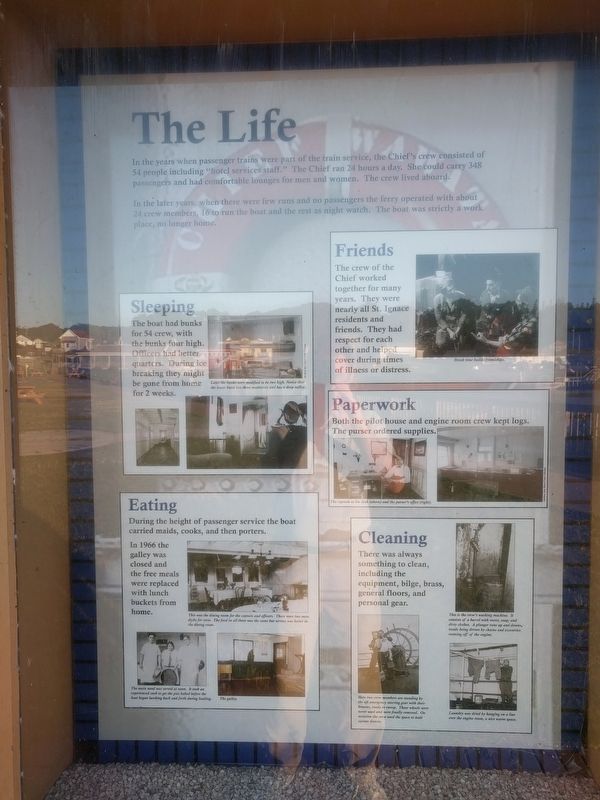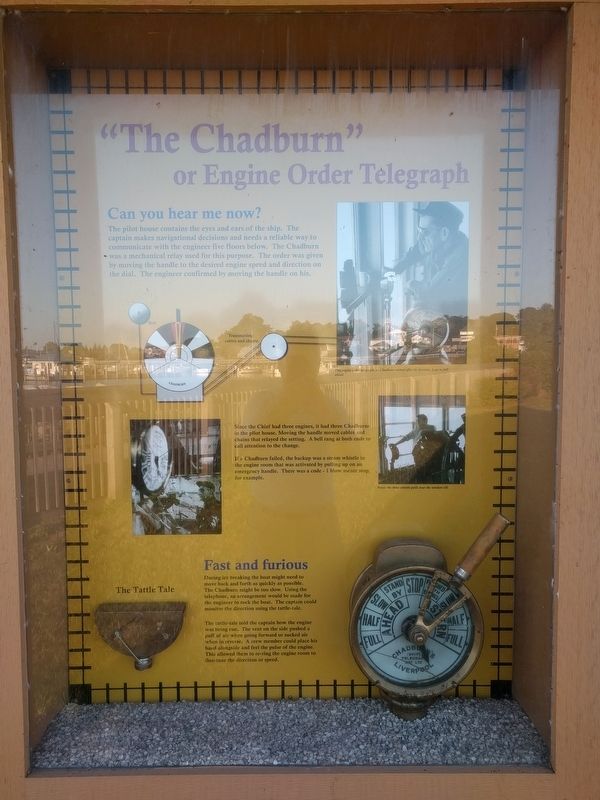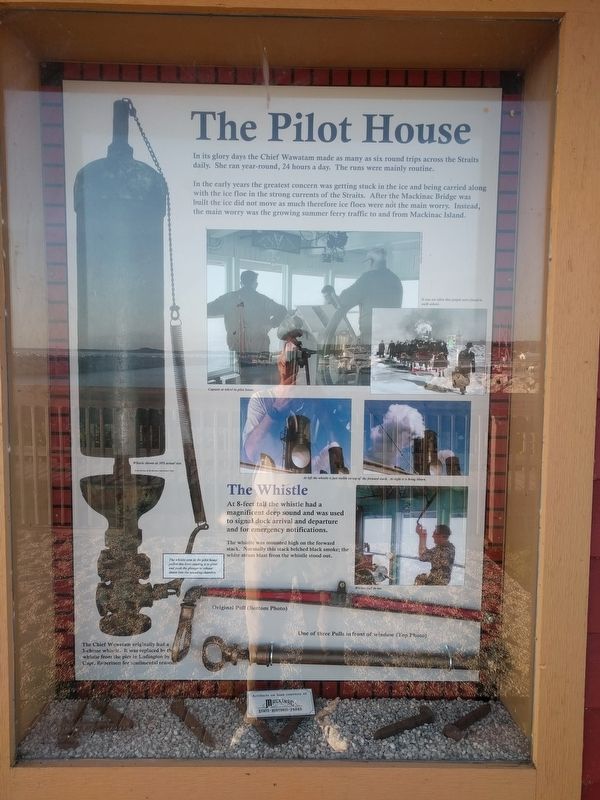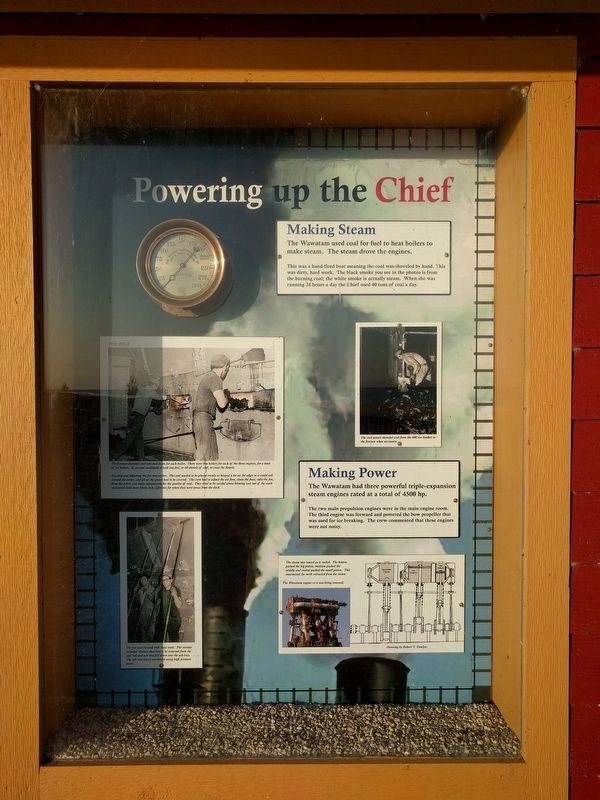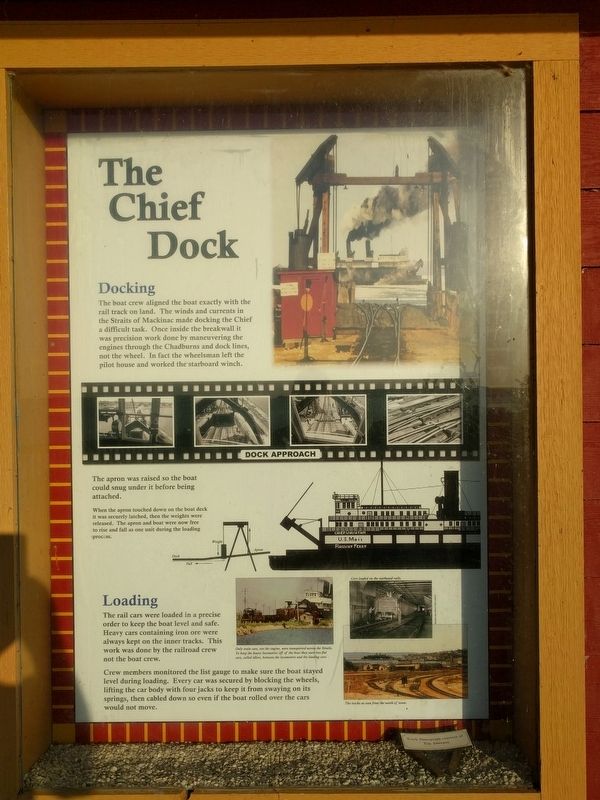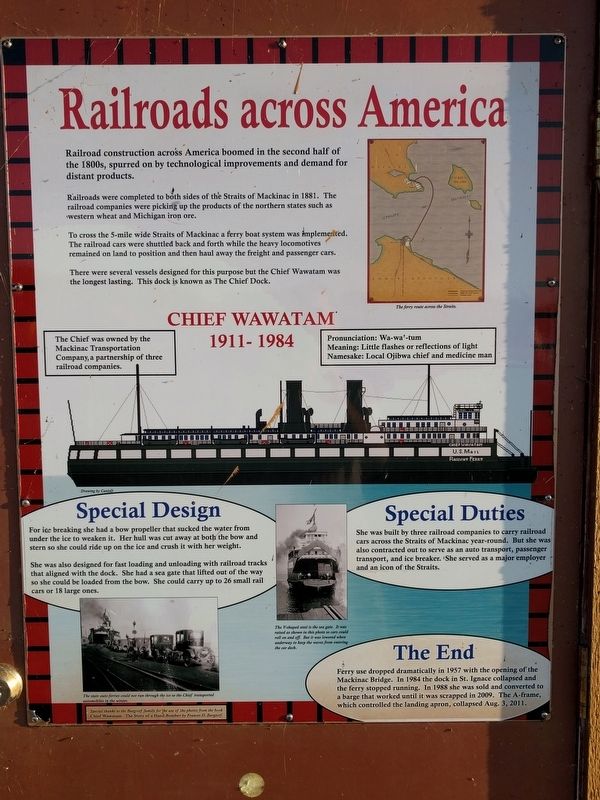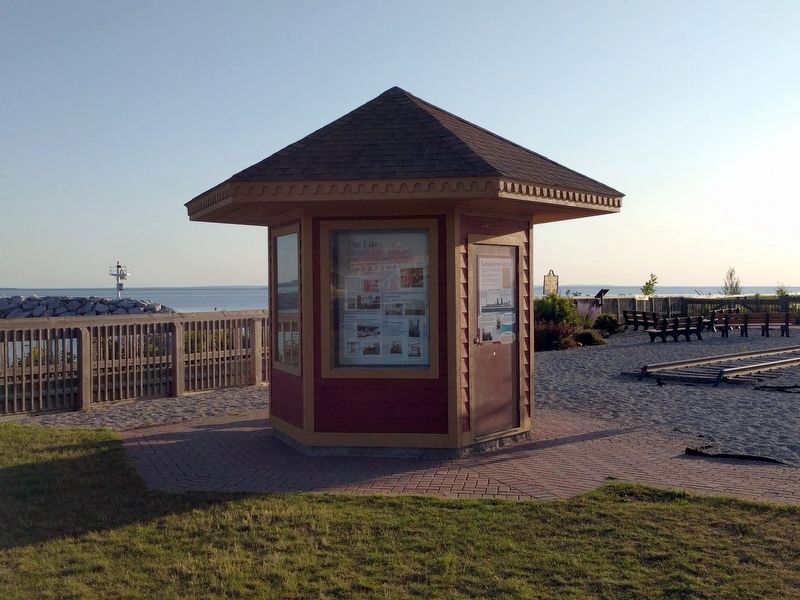St. Ignace in Mackinac County, Michigan — The American Midwest (Great Lakes)
The Chief Dock Kiosk
Panel 1 — The Life
In the years when passenger trains were part of the train service, the Chief's crew consisted of 54 people including "hotel services staff." The Chief ran 24 hours a day. She could carry 348 passengers and had comfortable lounges for men and women. The crew lived aboard.
In the later years, when there were few runs and no passengers the ferry operated with about 24 crew members, 16 to run the boat and the rest as night watch. The boat was strictly a work place, no longer home.
Sleeping
The boat had bunks for 54 crew, with the bunks four high. Officers had better quarters. During ice breaking they might be gone from home for 2 weeks.
Upper right photo caption: Later the bunks were modified to be two high. Notice that the lower bunk has three mattresses and had a deep valley.
Eating
During the height of passenger service the boat carried maids, cooks, and then porters. In 1966 the galley was closed and the free meals were replaced with lunch buckets from home.
Upper right photo caption: This was the dining room for the captain and officers. There were two mess decks for crew. The food in all three was the same but service was better in the dining room.
Lower left photo caption: The main meal was served at noon. It took an experienced cook to get the pies baked before the boat began lurching back and forth during loading.
Lower right photo caption: The galley.
Friends
The crew of the Chief worked together for many years. They were nearly all St. Ignace residents and friends. They had respect for each other and helped cover during times of illness or distress.
Photo caption: Break time builds friendships.
Paperwork
Both the pilot house and engine room crew kept logs. The purser ordered supplies.
Caption: The captain at his desk (above) and the purser's office (right).
Cleaning
There was always something to clean, including the equipment, bilge, brass, general floors, and personal gear.
Upper right photo caption: This is a crew's washing machine. It consists of a barrel with water, soap, and dirty clothes. A plunger runs up and down inside being driven by chains and eccentrics running off of the engine.
Lower left photo caption: Here two crew members are standing by the aft emergency steering gear with their brooms, ready to sweep. These wheels were never used and were finally removed. On occasion the crew used the space to hold square dances.
Lower right photo caption: Laundry was dried by hanging on a line over the engine room, a nice warm space.
Panel 2 — "The Chadburn" or Engine Order Telegraph
Can you hear me now?
The pilot house contains the eyes and ears of the ship. The captain makes navigational decisions and needs a reliable way to communicate with the engineer five floors below. The Chadburn was a mechanical relay used for this purpose. The order was given by moving the handle to the desired engine speed and direction on the dial. The engineer confirmed by moving the handle on his.
Since the Chief had three engines, it had three Chadburns in the pilot house. Moving the handle moved cables and chains that relayed the setting. A bell rang at both ends to call attention to the change.
If a Chadburn failed, the backup was a steam whistle in the engine room that was activated by pulling up on an emergency handle. There was a code - 1 blow meant stop, for example.
Fast and furious
During ice breaking the boat might need to move back and forth as quickly as possible. The Chadburn might be too slow. Using the telephone, an arrangement would be made for the engineer to rock the boat. The captain could monitor the direction using the tattle-tale.
The tattle-tale told the captain how the engine was being run. The vent on the side pushed a puff of air when going forward or sucked air when in reverse. A crew member could place his hand alongside and feel the pulse of the engine. This allowed them to re-ring the engine room to fine-tune the direction or speed.
Upper right photo caption: The engine order telegraph, or Chadburn named after its inventor, is set to full ahead.
Middle right photo caption: Notice the three whistle-pulls near the window sill.
Panel 3 — The Pilot House
In its glory days the Chief Wawatam made as many as six round trips across the Straits daily. She ran year-round, 24 hours a day. The runs were mainly routine.
In the early years the greatest concern was getting stuck in the ice and being carried along with the ice floe in the strong currents of the Straits. After the Mackinac Bridge was built the ice did not move as much therefore ice floes were not the main worry. Instead, the main worry was the growing summer traffic to and from Mackinac Island.
The Whistle
At 8-feet tall the whistle had a magnificent deep sound and was used to signal dock arrival and departure and for emergency notifications.
The whistle was mounted high on the forward stack. Normally this stack belched black smoke; the white steam blast from the whistle stood out.
Upper row of photos captions — Left: Captain at wheel in pilot house. Right: It was not often that people were forced to walk ashore.
Middle row of photos caption: At left the whistle is just visible on top of the forward stack. At right it is being blown.
Lower photo caption: Whistle pull in use.
Whistle captions — Top: Whistle shown at 50% actual size. (In the collection of the Mackinac State Historic Parks) Middle: The whistle arm in the pilot house pulled this lever causing it to pivot and push the plunger to release steam into the sounding chamber. Bottom: The Chief Wawatam originally had a 3-chime whistle. It was replaced by this whistle from the pier in Ludington by Capt. Robertson for sentimental reasons.
Whistle pull captions — Top: Original Pull (Bottom Photo) Bottom: One of three Pulls in front of window (Top Photo)
Panel 4 — Powering up the Chief
Making Steam
The Wawatam used coal for fuel to heat boilers to make steam. The steam drove the engines.
This was a hand-fired boat meaning the coal was shoveled by hand. This was dirty, hard work. The black smoke you see in the photos is from the burning coal; the white smoke is actually steam. When she was running 24 hours a day the Chief used 40 tons of coal a day.
Making Power
The Wawatam had three powerful triple-expansion steam engines rated at a total of 4500 hp.
The two main propulsion engines were in the main engine room. The third engine was forward and powered the bow propeller that was used for ice breaking. The crew commented that these engines were not noisy.
Top left photo caption: The firemen shoveled coal into two doors for each boiler. There were two boilers for each of the three engines, for a total of six boilers. In normal conditions it took one fire, or 40 shovels of coal, to cross the Straits.
Reading and adjusting the fire was an art. The coal needed to be placed evenly or heaped a bit on the edges so it could roll toward the center, and all of the grates had to be covered. The crew had to adjust the air flow, clean the flues, rake the fire, blow the ashes, and make adjustments for the quality of coal. They tried to be careful about blowing soot out of the stack and saved tasks most likely to be offensive for when they were away from the dock.
Top right photo caption: The coal-passer shoveled coal from the 600 ton bunker to the firemen when necessary.
Bottom left photo caption: The fire was cleaned with these tools. The residue included clinkers that had to be removed from the coal bed and ash that fell down into the ash tray. The ash was blown overboard using high pressure water.
Bottom right photo caption: The steam was reused as it cooled. The hottest pushed the big piston, medium pushed the middle and coldest pushed the small piston. This maximized the work extracted from the steam.
The Wawatam engine as it was being removed.
Panel 5 — The Chief Dock
Docking
The boat crew aligned the boat exactly with the rail track on land. The winds and currents in the Straits of Mackinac made docking the Chief a difficult task. Once inside the breakwall it was precision work done by maneuvering the engines through the Chadburns and dock lines, not the wheel. In fact the wheelsman left the pilot house and worked the starboard winch.
The apron was raised so the boat could snug under it before being attached.
When the apron touched down on the boat deck it was securely latched, then the weights were released. The apron and boat were now free to rise and fall as one unit during the loading process.
Loading
The rail cars were loaded in a precise order to keep the boat level and safe. Heavy cars containing iron ore were always left on the inner tracks. This work was done by the railroad crew not the boat crew.
Crew members monitored the list gauge to make sure the boat stayed level during loading. Every car was secured by blocking the wheels, lifting the car body with four jacks to keep it from swaying on its springs, then cabled down so even if the boat rolled over the cars would not move.
Bottom three photo captions
Upper left: Only train cars, not the engine, were transported across the Straits. To keep the heavy locomotive off of the boat they used two flat cars, called idlers, between the locomotive and the loading cars.
Upper right: Cars loaded on the starboard rails (Mackinac State Historic Parks Collection)
Lower: The tracks as seen from the north of town.
Panel 6 — Railroads across America
Railroad construction across America boomed in the second half of the 1800s, spurred on by technological improvements and demand for distant products.
Railroads were completed to both sides of the Straits of Mackinac in 1881. The railroad companies were picking up the products of the northern states such as western wheat and Michigan iron ore.
To cross the 5-mile wide Straits of Mackinac a ferry boat system was implemented. The railroad cars were shuttled back and forth while the heavy locomotives remained on land to position and then haul away the freight and passenger cars.
There were several vessels designed for this purpose but the Chief Wawatam was the longest lasting. This dock is known as The Chief Dock.
1911 - 1984
Pronunciation: Wa-wa'-tum
Meaning: Little flashes or reflections of light
Namesake: Local Ojibwa chief and medicine man
Special Design
For ice breaking she had a bow propeller that sucked the water from under the ice to weaken it. Her hull was cut away at both the bow and stern so she could ride up on the ice and crush it with her weight.
She was also designed for fast loading and unloading with railroad tracks that aligned with the dock. She had a sea gate that lifted out of the way so she could be loaded from the bow. She could carry up to 26 small rail cars or 18 large ones.
Special Duties
She was built by three railroad companies to carry railroad cars across the Straits of Mackinac year-round. But she was also contracted out to serve as an auto transport, passenger transport, and ice breaker. She served as a major employer and an icon of the Straits.
The End
Ferry use dropped dramatically in 1957 with the opening of the Mackinac Bridge. In 1984 the dock in St. Ignace collapsed and the ferry stopped running. In 1988 she was sold and converted to a barge that worked until it was scrapped in 2009. The A-frame, which controlled the landing apron, collapsed Aug. 3, 2011.
Upper right image caption: The ferry route across the Straits.
Lower left photo caption: The state auto ferries could not run through the ice so the Chief transported automobiles in the winter.
Lower right photo caption: The V-shaped steel is the sea gate. It was raised as shown in this photo so cars could roll on and off. But it was lowered when underway to keep the waves from entering the car deck.
Special thanks to the Burgtorf family for the use of the photos from the book Chief Wawatam - The Story of a Hand-Bomber by Frances D. Burgtorf.
Topics. This historical marker is listed in these topic lists: Railroads & Streetcars • Waterways & Vessels. A significant historical date for this entry is August 3, 2011.
Location. 45° 51.926′ N, 84° 43.029′ W. Marker is in St. Ignace, Michigan, in Mackinac County. Marker can be reached from North State Street (Business Interstate 75) east of McCann Street, on the right when traveling north. Marker is in Chief Wawatam Park next to the Huron Boardwalk. Touch for map. Marker is at or near this postal address: 251 North State Street, Saint Ignace MI 49781, United States of America. Touch for directions.
Other nearby markers. At least 8 other markers are within walking distance of this marker. Antique Railroad Bell (a few steps from this marker); The Chief Dock (within shouting distance of this marker); Mooring Facilities (within shouting distance of this marker); France at Mackinac (about 600 feet away, measured in a direct line); Heritage of Fishermen in this Area (about 700 feet away); Great Lakes Shipwrecks and Michigan's Underwater Preserves (about 700 feet away); State Ferries, 1923-1957 (about 800 feet away); Veterans Memorial (approx. 0.2 miles away). Touch for a list and map of all markers in St. Ignace.
Credits. This page was last revised on September 23, 2019. It was originally submitted on September 23, 2019, by Joel Seewald of Madison Heights, Michigan. This page has been viewed 225 times since then and 20 times this year. Photos: 1, 2, 3, 4, 5, 6, 7. submitted on September 23, 2019, by Joel Seewald of Madison Heights, Michigan.
